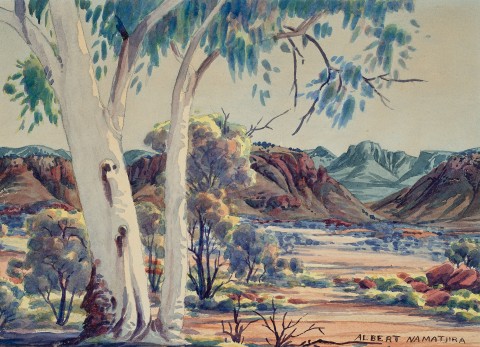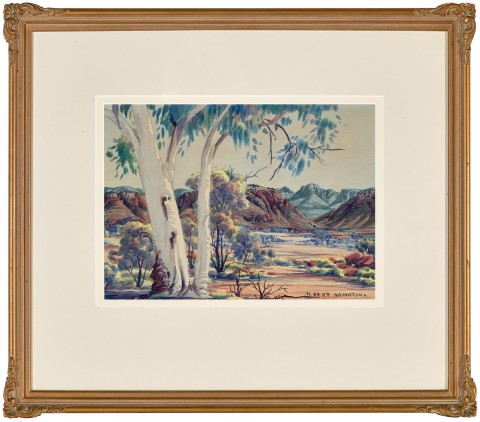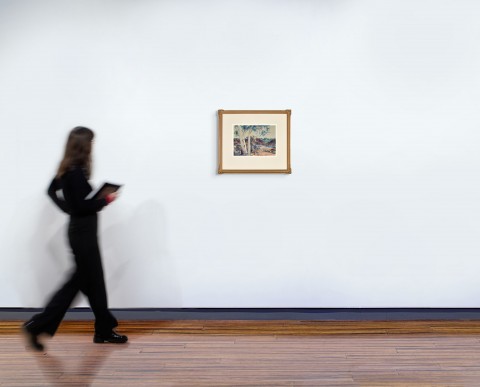RANGES 10 MILES NORTH FROM ALICE SPRINGS, c.1954
ALBERT NAMATJIRA
watercolour on paper
26.0 x 37.0 cm
signed lower right: ALBERT NAMATJIRA
signed and inscribed with title verso: Ranges 10 Miles North from Alice Springs / Albert Namatjira
Private collection
Leonard Joel, Melbourne, 16 April 1986, lot 30
Joy Willis, Sydney
Private collection, Sydney
Australian Icons, Historic Houses Trust of New South Wales, Greenway Gallery, Hyde Park Barracks, Sydney, 19 – 23 August 1992
Herbert, X., Poor Fellow My Country, Collins Australia, Sydney, 1975, cover (illus.)
Luck, P., Australian Icons, Things that make us what we are, William Heinemann, Australia, 1992, pp. 26, 27 (illus.)
Alice Springs Country, c.1955 – 59, watercolour on paper, 37.5 x 53.0 cm, private collection, illus. in French, A. (ed.), Seeing the Centre; The Art of Albert Namatjira 1902-1959, National Gallery of Australia, Canberra, 2002, p. 143
North Ranges Looking South, 1950s, watercolour on paper, 30.5 x 41.0 cm, in the collection of the Art Gallery of New South Wales, Sydney
‘Albert Namatjira…emerges…as an artist of genuine creativity, whose work embodied the love of, and identification with the land.’1
A household name by the 1950s, Albert Namatjira set the foundations for the Indigenous art movement that emerged thirty years later and is still flourishing today. 'In skillfully adopting the methods and materials of Western landscape painting, he challenged the relegation of Aboriginal art to the realm of archaeology and ethnography.'2
Painted in the final years of the artist’s life, and replete with the artist’s recurring motifs, Ranges 10 Miles North from Alice Springs epitomises Namatjira’s later works. Located in the foreground, a majestic ghost gum, (Eucalyptus papuana), known as ilwempe to the Western Arrernte, frames the viewpoint which is carefully controlled by the artist who directs the viewer to the distant peaks through the placement of intervening slopes in the middle distance, and then to the outlying mountain peaks beyond. Presenting a more open, horizontal and expansive experience of the landscape, Namatjira’s familiarity with this country is evident in these views where ‘trees, peaks and monoliths provide a rich range of possibilities and responses that arise from constantly re-engaging with the same subject.’3
In transporting his evocative landscapes of Central Australia into the lounge rooms of White Australia in the mid-twentieth century, his depictions of country were fundamental to how Australians viewed their island home. Namatjira's entry into the Australian art world was both inspired and inspiring. Despite his personal vicissitudes, he inspired his own and subsequent generations of Aboriginal people and artists across Australia and sought to educated non-indigenous Australians about the spiritual link between indigenous people and land. Brenda Croft contends that the artist’s gift to indigenous and non-indigenous people is ‘more than the sum parts of watercolour paints on paper. It is an essence that resides in the strength of Namatjira’s work – his courage, his sorrow, his spirituality… where the enduring influence of this one man upon the entire indigenous arts and culture industry continues to be felt.’4
1. Nuggett Coombs, H.C., ‘Introduction’ in Amadio, N., Albert Namatjira; The Life and Work of an Australian Painter, Macmillan, Melbourne 1986, p. vii
2. Watson, K., ‘Poetic Justice: an overview of Indigenous Art’, in Perkins, H., One Sun, One Moon: Aboriginal Art in Australia, Art Gallery of New South Wales, Sydney, 2007, p. 20
3. French, A., Seeing the Centre: The Art of Albert Namatjira 1902 – 1959, National Gallery of Australia, Canberra, 2002, p. 97
4. Croft, B., ‘Albert’s Gift’ in French, ibid., p. 148
CRISPIN GUTTERIDGE


